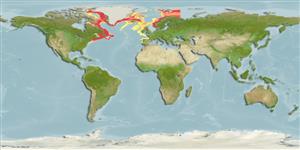Common names from other countries
Environment: milieu / climate zone / depth range / distribution range
Écologie
marin bathydémersal; profondeur 165 - 1342 m (Ref. 58426), usually 165 - 215 m (Ref. 42091). Deep-water; 79°N - 38°N, 76°W - 36°E
North Atlantic: English Channel, North Sea, Norwegian coastline, Svalbard, southwestern Barents Sea, off Spitzbergen, Bear Island, the Faeroes and Iceland, southeastern coasts of Greenland. Western Atlantic: New Jersey, USA to Gulf of St. Lawrence, Canada and Greenland.
Taille / Poids / Âge
Maturity: Lm ? range ? - ? cm
Max length : 30.0 cm SL mâle / non sexé; (Ref. 35388); common length : 14.0 cm SL mâle / non sexé; (Ref. 6696)
Description synthétique
Clés d'identification | Morphologie | Morphométrie
Four bony knobs between and behind the eyes. Skin very rough. Body with 3-4 broad, dark vertical bands (Ref. 35388).
Benthic (Ref. 58426). Feeds on polychaetes, mysids, amphipods and pycnogonids. Spawns probably from June to July, ovarian eggs large and few (up to 220) (Ref. 6696). Female lays 200 eggs with a length of 4.5-5 mm (Ref. 35388).
Life cycle and mating behavior
Maturities | Reproduction | Spawnings | Egg(s) | Fecundities | Larves
Fedorov, V.V. and J.S. Nelson, 1986. Psychrolutidae. p. 1261-1264. In P.J.P. Whitehead, M.-L. Bauchot, J.-C. Hureau, J. Nielsen and E. Tortonese (eds.) Fishes of the North-eastern Atlantic and the Mediterranean. UNESCO, Paris. Vol 3. (Ref. 6696)
Statut dans la liste rouge de l'IUCN (Ref. 130435)
CITES (Ref. 128078)
Not Evaluated
Menace pour l'homme
Harmless
Utilisations par l'homme
Pêcheries: sans intérêt
Outils
Articles particuliers
Télécharger en XML
Sources Internet
Estimates based on models
Preferred temperature (Ref.
115969): 0.3 - 7.7, mean 2.6 (based on 243 cells).
Phylogenetic diversity index (Ref.
82804): PD
50 = 0.5039 [Uniqueness, from 0.5 = low to 2.0 = high].
Bayesian length-weight: a=0.00389 (0.00180 - 0.00842), b=3.12 (2.94 - 3.30), in cm Total Length, based on all LWR estimates for this body shape (Ref.
93245).
Niveau trophique (Ref.
69278): 4.1 ±0.2 se; based on diet studies.
Résilience (Ref.
120179): Faible, temps minimum de doublement de population : 4,5 à 14 années (Fec = 66).
Fishing Vulnerability (Ref.
59153): Low to moderate vulnerability (27 of 100).
